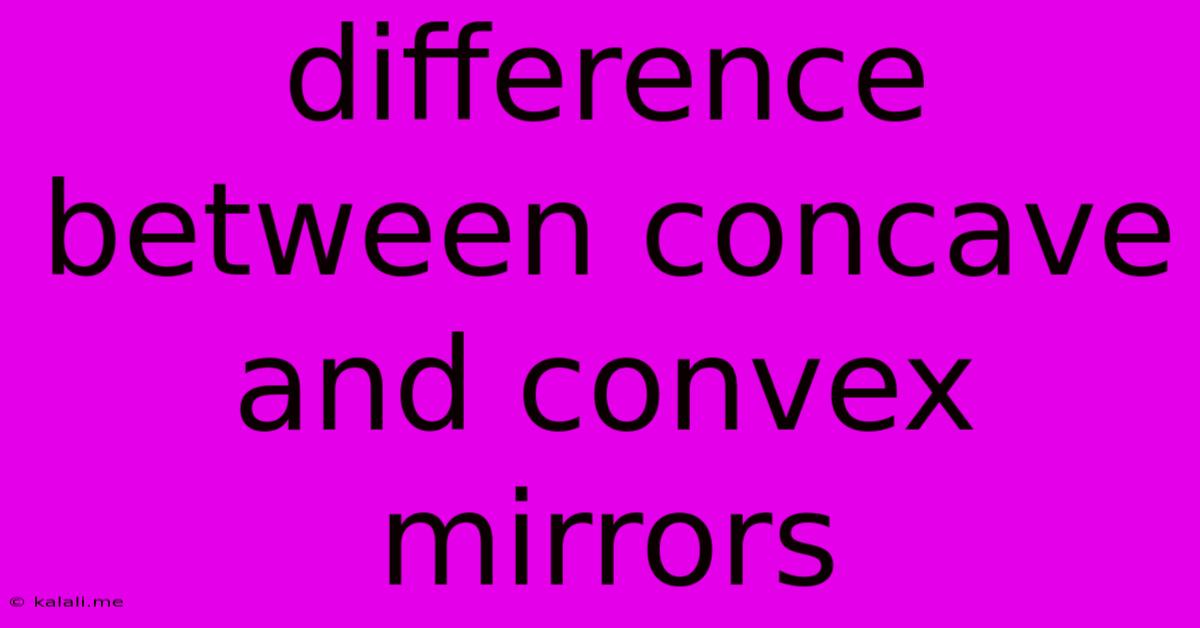Difference Between Concave And Convex Mirrors
Kalali
Jun 13, 2025 · 3 min read

Table of Contents
Concave vs. Convex Mirrors: Understanding the Differences
This article explores the key differences between concave and convex mirrors, covering their shapes, image formations, and practical applications. Understanding these distinctions is crucial for anyone studying optics or interested in the practical applications of mirrors in various fields.
What is a Concave Mirror?
A concave mirror curves inward, like the inside of a sphere. This inward curve is what dictates its unique properties. The focal point, where parallel light rays converge after reflection, is located in front of the mirror. This feature is fundamental to understanding how concave mirrors form images.
Image Formation in Concave Mirrors:
The type of image formed by a concave mirror depends on the object's position relative to the focal point (F) and the center of curvature (C).
- Object beyond C: A real, inverted, and diminished image is formed between F and C. This is the principle behind astronomical telescopes.
- Object at C: A real, inverted, and same-size image is formed at C.
- Object between C and F: A real, inverted, and magnified image is formed beyond C. This is the principle behind many reflecting telescopes and some types of microscopes.
- Object at F: No image is formed; the reflected rays are parallel.
- Object between F and the mirror: A virtual, upright, and magnified image is formed behind the mirror. This is useful for shaving mirrors and makeup mirrors.
Applications of Concave Mirrors:
Concave mirrors are used extensively due to their ability to magnify images and focus light. Some key applications include:
- Telescopes: Reflecting telescopes use large concave mirrors to gather and focus light from distant stars and planets.
- Headlights and spotlights: The concave shape focuses light into a concentrated beam.
- Solar cookers: The concentrated sunlight heats the food efficiently.
- Dental and medical instruments: Magnified images aid in precise procedures.
What is a Convex Mirror?
A convex mirror curves outward, like the outside of a sphere. Unlike concave mirrors, the focal point of a convex mirror is located behind the mirror, making it a virtual focal point.
Image Formation in Convex Mirrors:
Convex mirrors always produce a virtual, upright, and diminished image, regardless of the object's position. The image is always located behind the mirror and is smaller than the object.
Applications of Convex Mirrors:
The primary advantage of a convex mirror is its wide field of view, making them ideal for security and safety applications.
- Car side mirrors: They provide a wider view of the surroundings, though with a diminished image size.
- Security mirrors: Used in shops and buildings to monitor larger areas.
- Street corners: Improve visibility at blind intersections.
Key Differences Summarized:
| Feature | Concave Mirror | Convex Mirror |
|---|---|---|
| Shape | Curves inward | Curves outward |
| Focal Point | In front of the mirror | Behind the mirror (virtual) |
| Image Type | Real or virtual, inverted or upright, magnified or diminished | Virtual, upright, diminished |
| Field of View | Narrow | Wide |
| Applications | Telescopes, headlights, solar cookers | Car mirrors, security mirrors |
Understanding the differences between concave and convex mirrors helps us appreciate their diverse applications in various fields, from astronomy and medicine to transportation and security. Their unique optical properties make them indispensable tools in our modern world.
Latest Posts
Latest Posts
-
Which Seismic Waves Cause The Most Damage
Jun 13, 2025
-
Which Of The Following Is Not True For Minerals
Jun 13, 2025
-
If Two Waves With Equal Amplitudes And Wavelengths
Jun 13, 2025
-
Which Of The Following Is Correct About Viruses
Jun 13, 2025
-
How Do You Separate Nitrogen And Oxygen
Jun 13, 2025
Related Post
Thank you for visiting our website which covers about Difference Between Concave And Convex Mirrors . We hope the information provided has been useful to you. Feel free to contact us if you have any questions or need further assistance. See you next time and don't miss to bookmark.